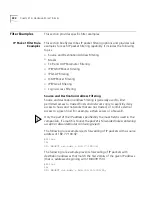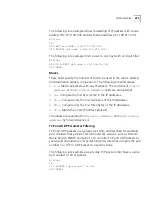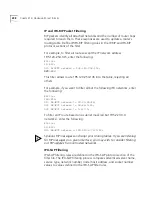
Creating Filters
223
Generic Filter Rules
Generic filter rules are similar in format to protocol filter rules. The
following shows the rule syntax. The following is the rule syntax:
<line #> <verb> <keyword> <operator> origin = <DATA | FRAME>/
offset = <value>/length = <value>/mask = <hexadecimal value>/
value = <hexadecimal value>;
Table 59 describes each field used in the rule syntax.
Table 59
Generic Filter Rules
For example, a generic filter rule might look like the following:
010 ACCEPT generic => origin = data/offset = 22/length = 6/
mask = 0xFFFFFFFFFFFF/value = 0x0800096f39c8;
Field
Description
line #
Each rule must have a unique line number (
1-999
). You must arrange
rules in increasing order.
verb
This field can be one of the following:
■
ACCEPT
—allow packet access if the condition is met
■
REJECT
— do not allow packet access if the condition is met
■
AND
— logically use the AND condition with condition of the next
rule to determine if packet is accepted or rejected. Both defined
conditions must be met.
IMPORTANT:
No more than 15 consecutive
AND rules are permitted.
keyword
The keywords for a generic filter rule is always
GENERIC
.
operator
The operator for a generic filter rule is always:
=>
origin
Can be either
FRAME
or
DATA
offset
This is the number of bytes offset from the origin.
length
This is the number of bytes to compare and mask.
mask
This is the bit mask, in hexadecimal format, for logical and packet
content. (
00
or
FF
)
value
This value, in hexadecimal format, is used to compare with contents of
masked packet
Summary of Contents for REMOTE ACCESS SYSTEM 1500
Page 14: ......
Page 40: ......
Page 58: ......
Page 120: ......
Page 130: ......
Page 158: ......
Page 178: ......
Page 202: ......
Page 266: ......
Page 286: ......
Page 292: ......
Page 297: ...INDEX 295 V 90 151 W Windows 95 Dial Up Networking 89 World Wide Web WWW 285 X X 75 152 ...
Page 298: ...296 INDEX ...
















































